FIAT FULLBACK 2017 Owner handbook (in English)
Manufacturer: FIAT, Model Year: 2017, Model line: FULLBACK, Model: FIAT FULLBACK 2017Pages: 312, PDF Size: 12.31 MB
Page 141 of 312
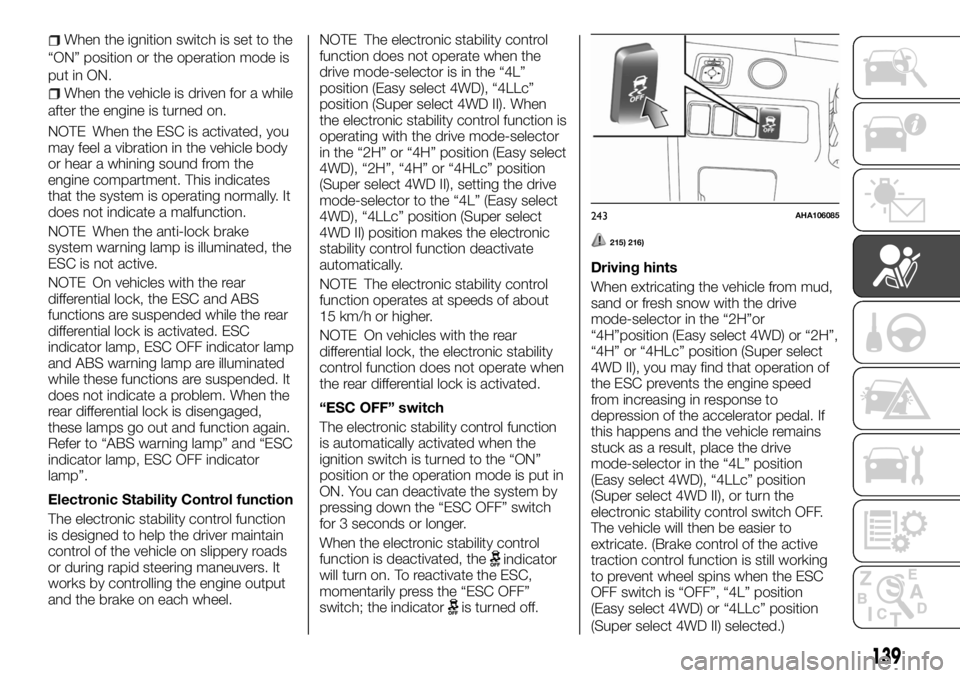
When the ignition switch is set to the
“ON” position or the operation mode is
put in ON.
When the vehicle is driven for a while
after the engine is turned on.
NOTE When the ESC is activated, you
may feel a vibration in the vehicle body
or hear a whining sound from the
engine compartment. This indicates
that the system is operating normally. It
does not indicate a malfunction.
NOTE When the anti-lock brake
system warning lamp is illuminated, the
ESC is not active.
NOTE On vehicles with the rear
differential lock, the ESC and ABS
functions are suspended while the rear
differential lock is activated. ESC
indicator lamp, ESC OFF indicator lamp
and ABS warning lamp are illuminated
while these functions are suspended. It
does not indicate a problem. When the
rear differential lock is disengaged,
these lamps go out and function again.
Refer to “ABS warning lamp” and “ESC
indicator lamp, ESC OFF indicator
lamp”.
Electronic Stability Control function
The electronic stability control function
is designed to help the driver maintain
control of the vehicle on slippery roads
or during rapid steering maneuvers. It
works by controlling the engine output
and the brake on each wheel.NOTE The electronic stability control
function does not operate when the
drive mode-selector is in the “4L”
position (Easy select 4WD), “4LLc”
position (Super select 4WD II). When
the electronic stability control function is
operating with the drive mode-selector
in the “2H” or “4H” position (Easy select
4WD), “2H”, “4H” or “4HLc” position
(Super select 4WD II), setting the drive
mode-selector to the “4L” (Easy select
4WD), “4LLc” position (Super select
4WD II) position makes the electronic
stability control function deactivate
automatically.
NOTE The electronic stability control
function operates at speeds of about
15 km/h or higher.
NOTE On vehicles with the rear
differential lock, the electronic stability
control function does not operate when
the rear differential lock is activated.
“ESC OFF” switch
The electronic stability control function
is automatically activated when the
ignition switch is turned to the “ON”
position or the operation mode is put in
ON. You can deactivate the system by
pressing down the “ESC OFF” switch
for 3 seconds or longer.
When the electronic stability control
function is deactivated, the
indicator
will turn on. To reactivate the ESC,
momentarily press the “ESC OFF”
switch; the indicator
is turned off.
215) 216)
Driving hints
When extricating the vehicle from mud,
sand or fresh snow with the drive
mode-selector in the “2H”or
“4H”position (Easy select 4WD) or “2H”,
“4H” or “4HLc” position (Super select
4WD II), you may find that operation of
the ESC prevents the engine speed
from increasing in response to
depression of the accelerator pedal. If
this happens and the vehicle remains
stuck as a result, place the drive
mode-selector in the “4L” position
(Easy select 4WD), “4LLc” position
(Super select 4WD II), or turn the
electronic stability control switch OFF.
The vehicle will then be easier to
extricate. (Brake control of the active
traction control function is still working
to prevent wheel spins when the ESC
OFF switch is “OFF”, “4L” position
(Easy select 4WD) or “4LLc” position
243AHA106085
139
(Super select 4WD II) selected.)
Page 142 of 312
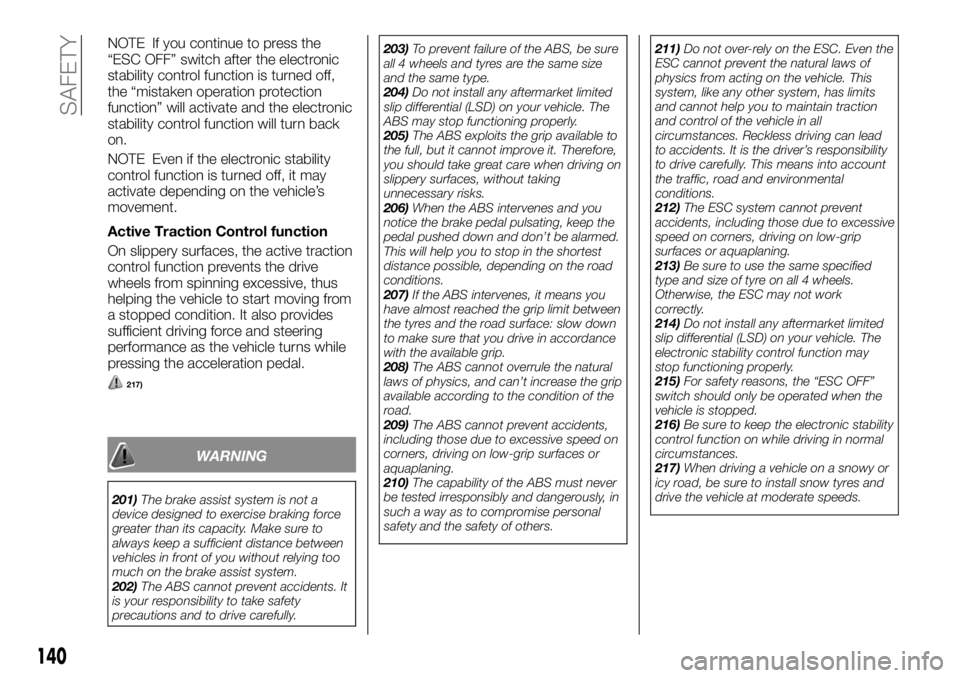
NOTE If you continue to press the
“ESC OFF” switch after the electronic
stability control function is turned off,
the “mistaken operation protection
function” will activate and the electronic
stability control function will turn back
on.
NOTE Even if the electronic stability
control function is turned off, it may
activate depending on the vehicle’s
movement.
Active Traction Control function
On slippery surfaces, the active traction
control function prevents the drive
wheels from spinning excessive, thus
helping the vehicle to start moving from
a stopped condition. It also provides
sufficient driving force and steering
performance as the vehicle turns while
pressing the acceleration pedal.
217)
WARNING
201)The brake assist system is not a
device designed to exercise braking force
greater than its capacity. Make sure to
always keep a sufficient distance between
vehicles in front of you without relying too
much on the brake assist system.
202)The ABS cannot prevent accidents. It
is your responsibility to take safety
precautions and to drive carefully.203)To prevent failure of the ABS, be sure
all 4 wheels and tyres are the same size
and the same type.
204)Do not install any aftermarket limited
slip differential (LSD) on your vehicle. The
ABS may stop functioning properly.
205)The ABS exploits the grip available to
the full, but it cannot improve it. Therefore,
you should take great care when driving on
slippery surfaces, without taking
unnecessary risks.
206)When the ABS intervenes and you
notice the brake pedal pulsating, keep the
pedal pushed down and don’t be alarmed.
This will help you to stop in the shortest
distance possible, depending on the road
conditions.
207)If the ABS intervenes, it means you
have almost reached the grip limit between
the tyres and the road surface: slow down
to make sure that you drive in accordance
with the available grip.
208)The ABS cannot overrule the natural
laws of physics, and can’t increase the grip
available according to the condition of the
road.
209)The ABS cannot prevent accidents,
including those due to excessive speed on
corners, driving on low-grip surfaces or
aquaplaning.
210)The capability of the ABS must never
be tested irresponsibly and dangerously, in
such a way as to compromise personal
safety and the safety of others.211)Do not over-rely on the ESC. Even the
ESC cannot prevent the natural laws of
physics from acting on the vehicle. This
system, like any other system, has limits
and cannot help you to maintain traction
and control of the vehicle in all
circumstances. Reckless driving can lead
to accidents. It is the driver’s responsibility
to drive carefully. This means into account
the traffic, road and environmental
conditions.
212)The ESC system cannot prevent
accidents, including those due to excessive
speed on corners, driving on low-grip
surfaces or aquaplaning.
213)Be sure to use the same specified
type and size of tyre on all 4 wheels.
Otherwise, the ESC may not work
correctly.
214)Do not install any aftermarket limited
slip differential (LSD) on your vehicle. The
electronic stability control function may
stop functioning properly.
215)For safety reasons, the “ESC OFF”
switch should only be operated when the
vehicle is stopped.
216)Be sure to keep the electronic stability
control function on while driving in normal
circumstances.
217)When driving a vehicle on a snowy or
icy road, be sure to install snow tyres and
drive the vehicle at moderate speeds.
140
SAFETY
Page 143 of 312
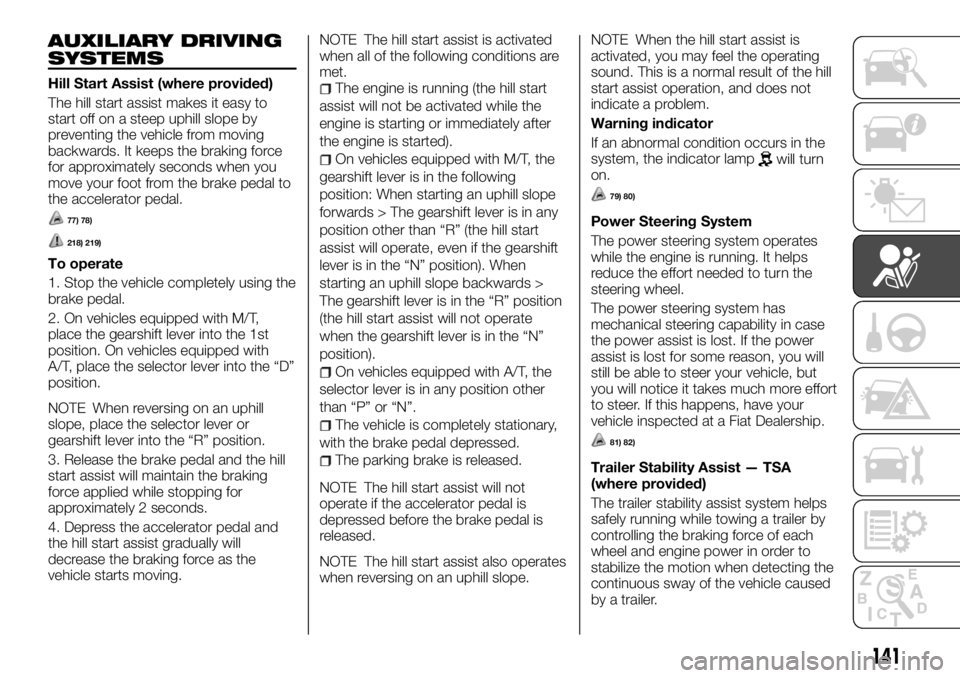
AUXILIARY DRIVING
SYSTEMS
Hill Start Assist (where provided)
The hill start assist makes it easy to
start off on a steep uphill slope by
preventing the vehicle from moving
backwards. It keeps the braking force
for approximately seconds when you
move your foot from the brake pedal to
the accelerator pedal.
77) 78)
218) 219)
To operate
1. Stop the vehicle completely using the
brake pedal.
2. On vehicles equipped with M/T,
place the gearshift lever into the 1st
position. On vehicles equipped with
A/T, place the selector lever into the “D”
position.
NOTE When reversing on an uphill
slope, place the selector lever or
gearshift lever into the “R” position.
3. Release the brake pedal and the hill
start assist will maintain the braking
force applied while stopping for
approximately 2 seconds.
4. Depress the accelerator pedal and
the hill start assist gradually will
decrease the braking force as the
vehicle starts moving.NOTE The hill start assist is activated
when all of the following conditions are
met.
The engine is running (the hill start
assist will not be activated while the
engine is starting or immediately after
the engine is started).
On vehicles equipped with M/T, the
gearshift lever is in the following
position: When starting an uphill slope
forwards > The gearshift lever is in any
position other than “R” (the hill start
assist will operate, even if the gearshift
lever is in the “N” position). When
starting an uphill slope backwards >
The gearshift lever is in the “R” position
(the hill start assist will not operate
when the gearshift lever is in the “N”
position).
On vehicles equipped with A/T, the
selector lever is in any position other
than “P” or “N”.
The vehicle is completely stationary,
with the brake pedal depressed.
The parking brake is released.
NOTE The hill start assist will not
operate if the accelerator pedal is
depressed before the brake pedal is
released.
NOTE The hill start assist also operates
when reversing on an uphill slope.NOTE When the hill start assist is
activated, you may feel the operating
sound. This is a normal result of the hill
start assist operation, and does not
indicate a problem.
Warning indicator
If an abnormal condition occurs in the
system, the indicator lamp
will turn
on.
79) 80)
Power Steering System
The power steering system operates
while the engine is running. It helps
reduce the effort needed to turn the
steering wheel.
The power steering system has
mechanical steering capability in case
the power assist is lost. If the power
assist is lost for some reason, you will
still be able to steer your vehicle, but
you will notice it takes much more effort
to steer. If this happens, have your
vehicle inspected at a Fiat Dealership.
81) 82)
Trailer Stability Assist — TSA
(where provided)
The trailer stability assist system helps
safely running while towing a trailer by
controlling the braking force of each
wheel and engine power in order to
stabilize the motion when detecting the
continuous sway of the vehicle caused
by a trailer.
141
Page 144 of 312
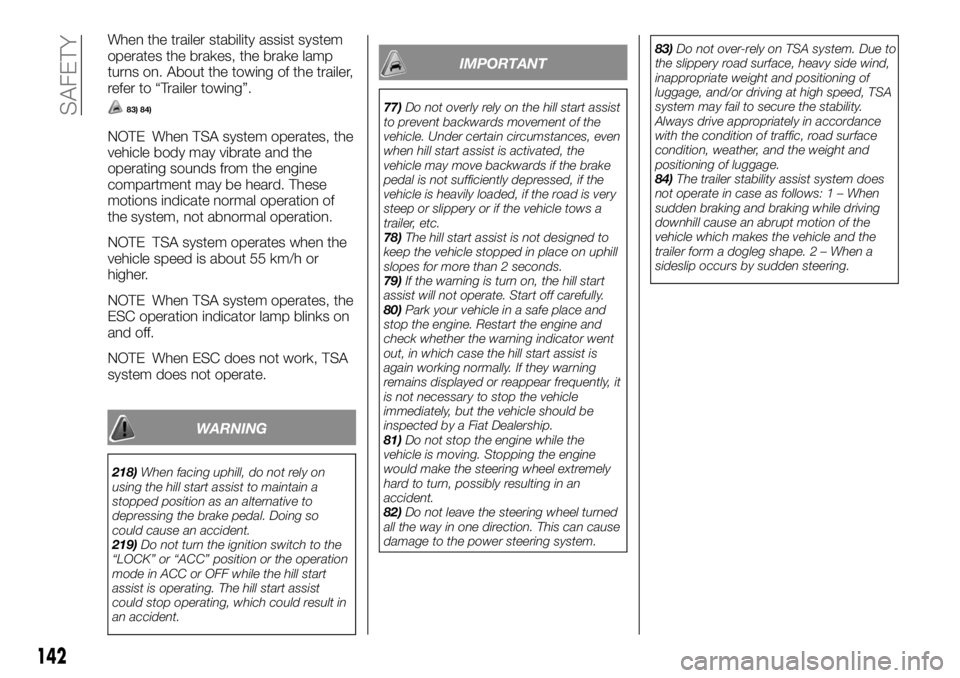
When the trailer stability assist system
operates the brakes, the brake lamp
turns on. About the towing of the trailer,
refer to “Trailer towing”.
83) 84)
NOTE When TSA system operates, the
vehicle body may vibrate and the
operating sounds from the engine
compartment may be heard. These
motions indicate normal operation of
the system, not abnormal operation.
NOTE TSA system operates when the
vehicle speed is about 55 km/h or
higher.
NOTE When TSA system operates, the
ESC operation indicator lamp blinks on
and off.
NOTE When ESC does not work, TSA
system does not operate.
WARNING
218)When facing uphill, do not rely on
using the hill start assist to maintain a
stopped position as an alternative to
depressing the brake pedal. Doing so
could cause an accident.
219)Do not turn the ignition switch to the
“LOCK” or “ACC” position or the operation
mode in ACC or OFF while the hill start
assist is operating. The hill start assist
could stop operating, which could result in
an accident.
IMPORTANT
77)Do not overly rely on the hill start assist
to prevent backwards movement of the
vehicle. Under certain circumstances, even
when hill start assist is activated, the
vehicle may move backwards if the brake
pedal is not sufficiently depressed, if the
vehicle is heavily loaded, if the road is very
steep or slippery or if the vehicle tows a
trailer, etc.
78)The hill start assist is not designed to
keep the vehicle stopped in place on uphill
slopes for more than 2 seconds.
79)If the warning is turn on, the hill start
assist will not operate. Start off carefully.
80)Park your vehicle in a safe place and
stop the engine. Restart the engine and
check whether the warning indicator went
out, in which case the hill start assist is
again working normally. If they warning
remains displayed or reappear frequently, it
is not necessary to stop the vehicle
immediately, but the vehicle should be
inspected by a Fiat Dealership.
81)Do not stop the engine while the
vehicle is moving. Stopping the engine
would make the steering wheel extremely
hard to turn, possibly resulting in an
accident.
82)Do not leave the steering wheel turned
all the way in one direction. This can cause
damage to the power steering system.83)Do not over-rely on TSA system. Due to
the slippery road surface, heavy side wind,
inappropriate weight and positioning of
luggage, and/or driving at high speed, TSA
system may fail to secure the stability.
Always drive appropriately in accordance
with the condition of traffic, road surface
condition, weather, and the weight and
positioning of luggage.
84)The trailer stability assist system does
not operate in case as follows: 1 – When
sudden braking and braking while driving
downhill cause an abrupt motion of the
vehicle which makes the vehicle and the
trailer form a dogleg shape. 2 – When a
sideslip occurs by sudden steering.
142
SAFETY
Page 145 of 312
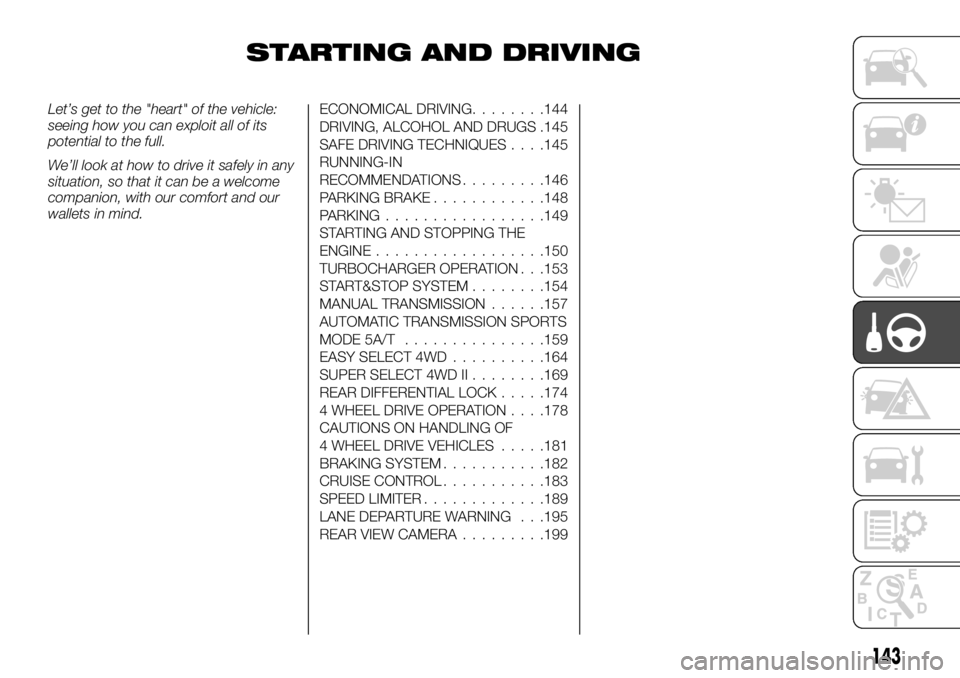
STARTING AND DRIVING
Let’s get to the "heart" of the vehicle:
seeing how you can exploit all of its
potential to the full.
We’ll look at how to drive it safely in any
situation, so that it can be a welcome
companion, with our comfort and our
wallets in mind.ECONOMICAL DRIVING........144
DRIVING, ALCOHOL AND DRUGS .145
SAFE DRIVING TECHNIQUES. . . .145
RUNNING-IN
RECOMMENDATIONS.........146
PARKING BRAKE............148
PARKING.................149
STARTING AND STOPPING THE
ENGINE..................150
TURBOCHARGER OPERATION . . .153
START&STOP SYSTEM........154
MANUAL TRANSMISSION......157
AUTOMATIC TRANSMISSION SPORTS
MODE 5A/T...............159
EASY SELECT 4WD..........164
SUPER SELECT 4WD II........169
REAR DIFFERENTIAL LOCK.....174
4 WHEEL DRIVE OPERATION. . . .178
CAUTIONS ON HANDLING OF
4 WHEEL DRIVE VEHICLES.....181
BRAKING SYSTEM...........182
CRUISE CONTROL...........183
SPEED LIMITER.............189
LANE DEPARTURE WARNING . . .195
REAR VIEW CAMERA.........199
143
Page 146 of 312
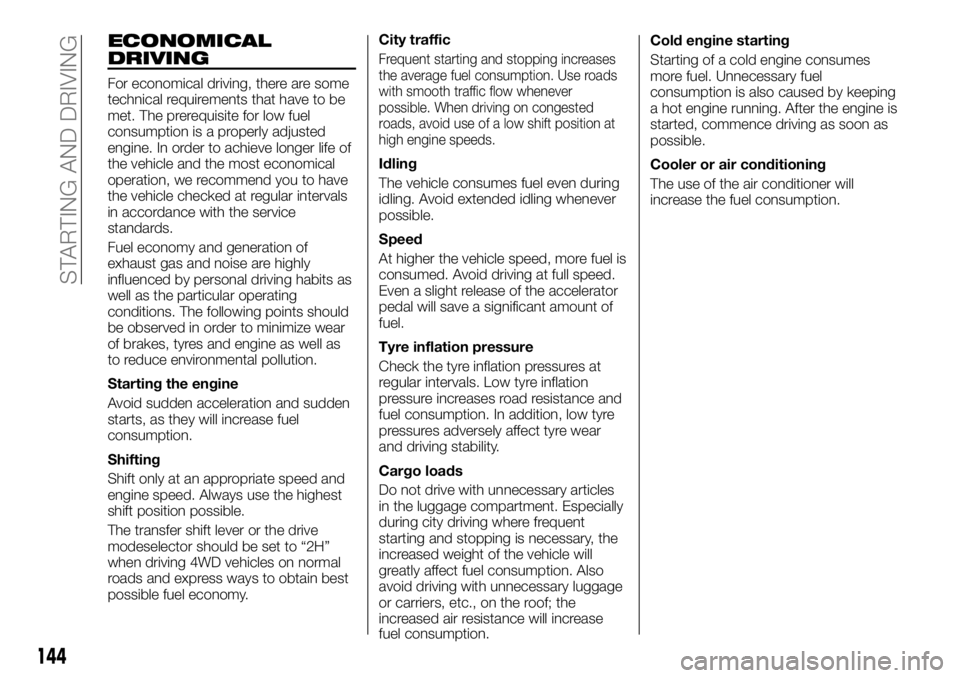
ECONOMICAL
DRIVING
For economical driving, there are some
technical requirements that have to be
met. The prerequisite for low fuel
consumption is a properly adjusted
engine. In order to achieve longer life of
the vehicle and the most economical
operation, we recommend you to have
the vehicle checked at regular intervals
in accordance with the service
standards.
Fuel economy and generation of
exhaust gas and noise are highly
influenced by personal driving habits as
well as the particular operating
conditions. The following points should
be observed in order to minimize wear
of brakes, tyres and engine as well as
to reduce environmental pollution.
Starting the engine
Avoid sudden acceleration and sudden
starts, as they will increase fuel
consumption.
Shifting
Shift only at an appropriate speed and
engine speed. Always use the highest
shift position possible.
The transfer shift lever or the drive
modeselector should be set to “2H”
when driving 4WD vehicles on normal
roads and express ways to obtain best
possible fuel economy.City traffic
Frequent starting and stopping increases
the average fuel consumption. Use roads
with smooth traffic flow whenever
possible. When driving on congested
roads, avoid use of a low shift position at
high engine speeds.
Idling
The vehicle consumes fuel even during
idling. Avoid extended idling whenever
possible.
Speed
At higher the vehicle speed, more fuel is
consumed. Avoid driving at full speed.
Even a slight release of the accelerator
pedal will save a significant amount of
fuel.
Tyre inflation pressure
Check the tyre inflation pressures at
regular intervals. Low tyre inflation
pressure increases road resistance and
fuel consumption. In addition, low tyre
pressures adversely affect tyre wear
and driving stability.
Cargo loads
Do not drive with unnecessary articles
in the luggage compartment. Especially
during city driving where frequent
starting and stopping is necessary, the
increased weight of the vehicle will
greatly affect fuel consumption. Also
avoid driving with unnecessary luggage
or carriers, etc., on the roof; the
increased air resistance will increase
fuel consumption.Cold engine starting
Starting of a cold engine consumes
more fuel. Unnecessary fuel
consumption is also caused by keeping
a hot engine running. After the engine is
started, commence driving as soon as
possible.
Cooler or air conditioning
The use of the air conditioner will
increase the fuel consumption.
144
STARTING AND DRIVING
Page 147 of 312
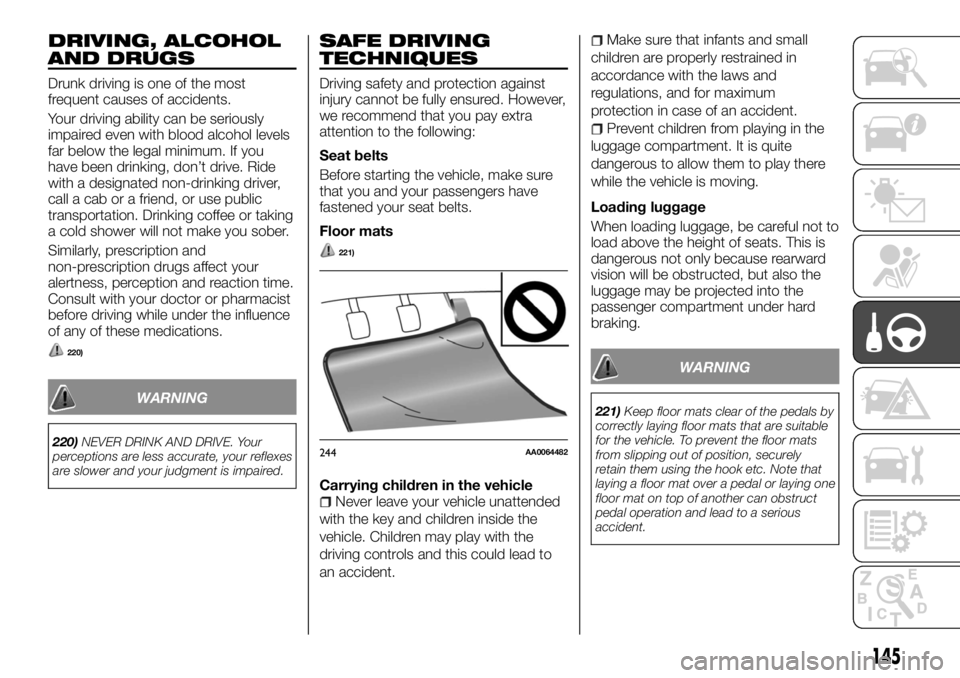
DRIVING, ALCOHOL
AND DRUGS
Drunk driving is one of the most
frequent causes of accidents.
Your driving ability can be seriously
impaired even with blood alcohol levels
far below the legal minimum. If you
have been drinking, don’t drive. Ride
with a designated non-drinking driver,
call a cab or a friend, or use public
transportation. Drinking coffee or taking
a cold shower will not make you sober.
Similarly, prescription and
non-prescription drugs affect your
alertness, perception and reaction time.
Consult with your doctor or pharmacist
before driving while under the influence
of any of these medications.
220)
WARNING
220)NEVER DRINK AND DRIVE. Your
perceptions are less accurate, your reflexes
are slower and your judgment is impaired.
SAFE DRIVING
TECHNIQUES
Driving safety and protection against
injury cannot be fully ensured. However,
we recommend that you pay extra
attention to the following:
Seat belts
Before starting the vehicle, make sure
that you and your passengers have
fastened your seat belts.
Floor mats
221)
Carrying children in the vehicleNever leave your vehicle unattended
with the key and children inside the
vehicle. Children may play with the
driving controls and this could lead to
an accident.
Make sure that infants and small
children are properly restrained in
accordance with the laws and
regulations, and for maximum
protection in case of an accident.
Prevent children from playing in the
luggage compartment. It is quite
dangerous to allow them to play there
while the vehicle is moving.
Loading luggage
When loading luggage, be careful not to
load above the height of seats. This is
dangerous not only because rearward
vision will be obstructed, but also the
luggage may be projected into the
passenger compartment under hard
braking.
WARNING
221)Keep floor mats clear of the pedals by
correctly laying floor mats that are suitable
for the vehicle. To prevent the floor mats
from slipping out of position, securely
retain them using the hook etc. Note that
laying a floor mat over a pedal or laying one
floor mat on top of another can obstruct
pedal operation and lead to a serious
accident.
244AA0064482
145
Page 148 of 312
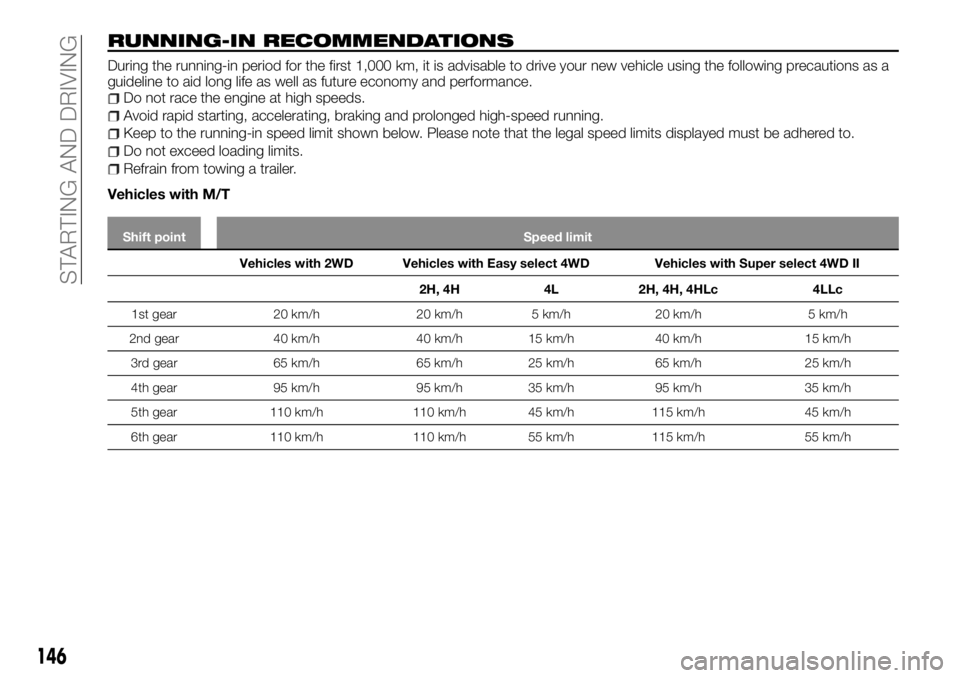
RUNNING-IN RECOMMENDATIONS
During the running-in period for the first 1,000 km, it is advisable to drive your new vehicle using the following precautions as a
guideline to aid long life as well as future economy and performance.
Do not race the engine at high speeds.
Avoid rapid starting, accelerating, braking and prolonged high-speed running.
Keep to the running-in speed limit shown below. Please note that the legal speed limits displayed must be adhered to.
Do not exceed loading limits.
Refrain from towing a trailer.
Vehicles with M/T
Shift point Speed limit
Vehicles with 2WD Vehicles with Easy select 4WD Vehicles with Super select 4WD II
2H, 4H 4L 2H, 4H, 4HLc 4LLc
1st gear 20 km/h 20 km/h 5 km/h 20 km/h 5 km/h
2nd gear 40 km/h 40 km/h 15 km/h 40 km/h 15 km/h
3rd gear 65 km/h 65 km/h 25 km/h 65 km/h 25 km/h
4th gear 95 km/h 95 km/h 35 km/h 95 km/h 35 km/h
5th gear 110 km/h 110 km/h 45 km/h 115 km/h 45 km/h
6th gear 110 km/h 110 km/h 55 km/h 115 km/h 55 km/h
146
STARTING AND DRIVING
Page 149 of 312
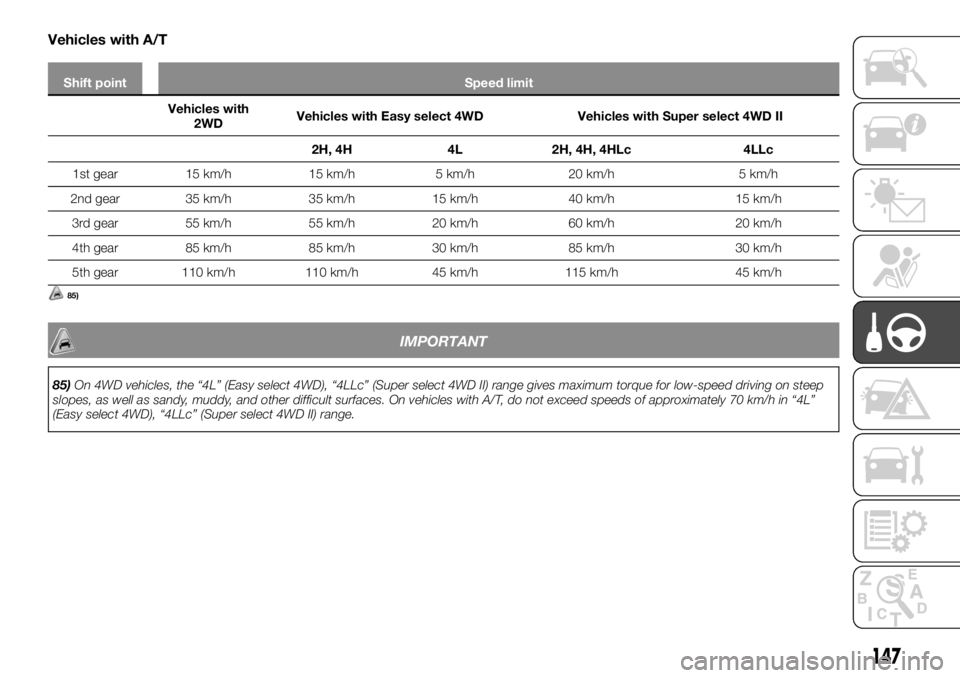
Vehicles with A/T
Shift point Speed limit
Vehicles with
2WDVehicles with Easy select 4WD Vehicles with Super select 4WD II
2H, 4H 4L 2H, 4H, 4HLc 4LLc
1st gear 15 km/h 15 km/h 5 km/h 20 km/h 5 km/h
2nd gear 35 km/h 35 km/h 15 km/h 40 km/h 15 km/h
3rd gear 55 km/h 55 km/h 20 km/h 60 km/h 20 km/h
4th gear 85 km/h 85 km/h 30 km/h 85 km/h 30 km/h
5th gear 110 km/h 110 km/h 45 km/h 115 km/h 45 km/h
85)
IMPORTANT
85)On 4WD vehicles, the “4L” (Easy select 4WD), “4LLc” (Super select 4WD II) range gives maximum torque for low-speed driving on steep
slopes, as well as sandy, muddy, and other difficult surfaces. On vehicles with A/T, do not exceed speeds of approximately 70 km/h in “4L”
(Easy select 4WD), “4LLc” (Super select 4WD II) range.
147
Page 150 of 312
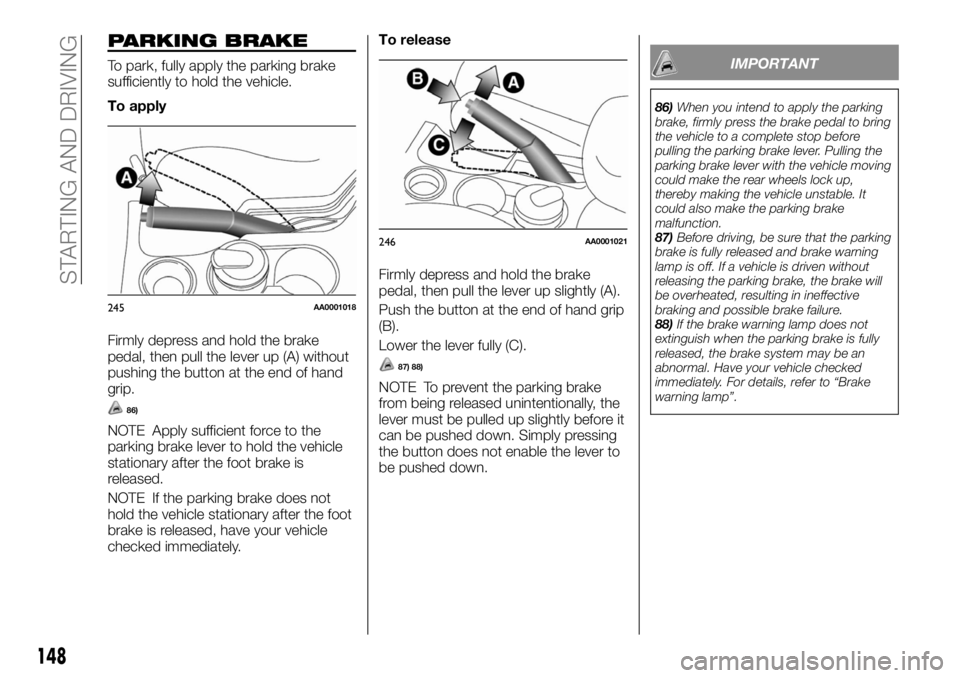
PARKING BRAKE
To park, fully apply the parking brake
sufficiently to hold the vehicle.
To apply
Firmly depress and hold the brake
pedal, then pull the lever up (A) without
pushing the button at the end of hand
grip.
86)
NOTE Apply sufficient force to the
parking brake lever to hold the vehicle
stationary after the foot brake is
released.
NOTE If the parking brake does not
hold the vehicle stationary after the foot
brake is released, have your vehicle
checked immediately.To release
Firmly depress and hold the brake
pedal, then pull the lever up slightly (A).
Push the button at the end of hand grip
(B).
Lower the lever fully (C).
87) 88)
NOTE To prevent the parking brake
from being released unintentionally, the
lever must be pulled up slightly before it
can be pushed down. Simply pressing
the button does not enable the lever to
be pushed down.
IMPORTANT
86)When you intend to apply the parking
brake, firmly press the brake pedal to bring
the vehicle to a complete stop before
pulling the parking brake lever. Pulling the
parking brake lever with the vehicle moving
could make the rear wheels lock up,
thereby making the vehicle unstable. It
could also make the parking brake
malfunction.
87)Before driving, be sure that the parking
brake is fully released and brake warning
lamp is off. If a vehicle is driven without
releasing the parking brake, the brake will
be overheated, resulting in ineffective
braking and possible brake failure.
88)If the brake warning lamp does not
extinguish when the parking brake is fully
released, the brake system may be an
abnormal. Have your vehicle checked
immediately. For details, refer to “Brake
warning lamp”.
245AA0001018
246AA0001021
148
STARTING AND DRIVING